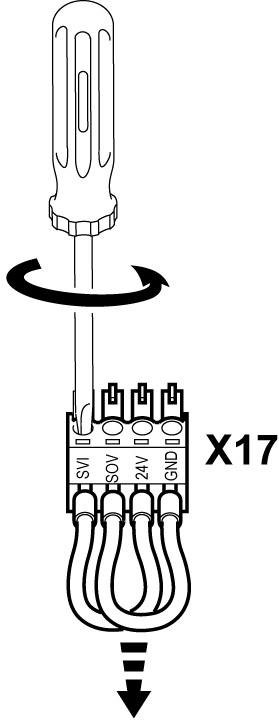Installation requirements
- For size 0 units of the type MC07B...-S0, an external 24 V supply must always be connected because the control electronics can only be powered in this way.
- The safety-related DC 24 V supply voltage must be routed according to EMC guidelines as follows:
- Outside an electrical installation space, shielded cables must be routed permanently (fixed) and protected against external damage, or other equivalent measures have to be taken.
- Individual conductors can be routed inside an electrical installation space.
- Adhere to the regulations in force for the application.
- Power cables and safety-related control cables must be installed in separate cables.
- Make sure that no parasitic voltages can be generated in the safety-related control cables.
- Wiring technology must comply with EN 60204-1.
- Use only grounded voltage sources with protective extra-low voltage (PELV) according to VDE0100 and EN 60204-1. In case of a single fault, the voltage between the outputs or between any output and grounded parts must not exceed DC 60 V.
- For information on EMC-compliant cabling, refer to the "® " operating instructions. It is essential that you connect the shield of the safety-related DC 24 V supply cable to the housing at both ends.
- The lines of the safety-related DC 24 V voltage supply (terminal X17) must be connected to the "signal electronics" shield clamp.
- When planning the installation, observe the technical data of ® .
- Observe without fail the values specified for safety components when designing the safety circuits.
- The cable length of the safety-related DC 24 V supply voltage must not exceed 100 m.
- The safety-related DC 24 V supply voltage may not be used for feedback.
- All connections (e.g. lines or data communication using bus systems) must already have been taken into account in the performance level of one of the subsystems involved, or it must be possible that faults in the connections can be excluded or neglected.
- The fault assumption "short circuit between any two conductors" can be excluded in accordance with EN ISO 13849-2:2012 under the following conditions:
- The conductors are
- Permanently (fixed) installed and protected against external damage (for example using a cable duct or armored conduit).
- Installed in different light plastic-sheathed cables in an electrical installation space provided that both the lines and the installation space meet the relevant requirements, see EN 60204-1.
- Protected individually by a ground connection.
- The fault assumption "short circuit between any conductor and an exposed conductive part or ground or a protective conductor" can be excluded under the following condition:
- Short circuits between a conductor and any exposed conductive part within an installation space.
- For applications with safety-related disconnection, remove the jumpers on X17:1 to X17:4 (see following figure).
|
1797603595 |
